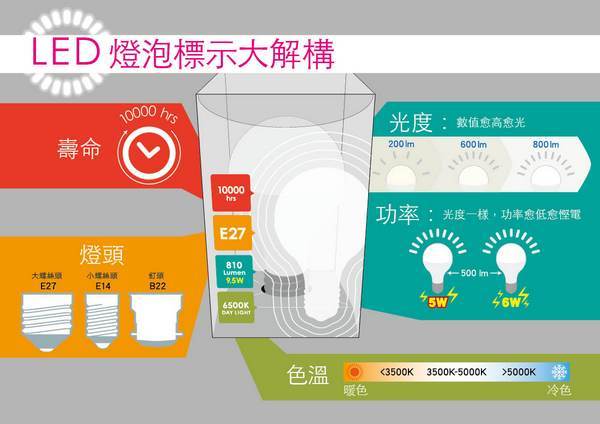Hong Kong Consumer Council and Electrical and Mechanical Services Department (EMSC) found large disparities in energy efficiency and lifetime performances in 10 types of LED bulbs, among these included products from leading lighting brands. Differences in LED bulb efficacy reached 100%, while one sample burned out and lumen depreciation in certain products occurred at 10% mark of the product’s lifetime. A couple other products failed to pass safety tests. Consumers were advised by the council to choose LED products cautiously.
The council commissioned an independent la_boratory in Hong Kong to test LED bulbs energy efficiency, and photobiological safety standards. LED bulbs energy efficiency tests require the bulbs to be tested after 6,000 hours (or about 8 months) usage, but due to many new LED bulbs released on the market to prevent products from becoming obsolete before the report was published, the council shortened test time to 3,000 hours (about four months).
The council found Panasonic, Ledus, LKKM, Sunshine and IKEA bulbs luminous depreciation declined more than 5% after 3,000 hours of operation, and failed to meet EMSD voluntary energy efficacy label demands, according to a Wenwei Po report. Out of these, Hong Kong LED manufacturer, Sunshine’s, average luminous depreciation reached 30%, about 90% below the advocated 30,000 hour lifespan. The company’s products delivered a miserable performance, six out of 10 samples brightness plunged 70% after 3,000 hours, one even burned out. A far cry from the company’s promoted 30,000 hour lifetime.
 |
|
Hong Kong Consumer Council and EMSC find many LED bulbs in the Hong Kong market do not meet lifetime or energy efficacy standards. This photo is a simple diagram of LED lifetime, power, sockets and color temperature. (HKCC/LEDinside) |
EMSD Voluntary Energy Efficiency Labelling Scheme for LED light bulbs. According to the Scheme requirements, the lifespan is defined as the point at which the lumen output of a LED light bulb declined to 70% of its initial lumen when it is considered that the light bulb should be replaced. According to the council, only one brand’s product was spared from lumen depreciation at the 3,000 hour mark, while the others dropped 1.3% to 28.2%.
In its efficacy tests, the council found the higher the luminous efficacy, the better the energy efficiency for the same amount of lumen output. Luminous efficacy of the LED bulb models tested varied from 53.8lm/W to nearly double at 107 lm/W. LLKM bulbs delivered the best energy efficacy performance of 107 lm/W, and were also the brightest. In comparison, IKEA bulbs delivered the worst performance of 53.8 lm/W.
Moreover, three bulbs did not pass the EDSM safety tests including Ledus and LKKM bulbs, which both did not pass the electric shock and insulation tests. Additionally, the diffusers failed the torque test and the dimension of the lamp cap was slightly different from the standard lamp base. The EMSD commissioned a local independent laboratory to conduct safety test according to the international safety standard IEC 62560.
Furthermore, the marking of four models were found to be inadequate, for instance, missing the input current and frequency. The marking of another model was not legible after the rubbing test.
The rated voltage of most of the tested models are marked in range, such as 220V to 240V, therefore the wattage and lumen output measured by the Council under Hong Kong's mains voltage (220V) may not be suitable for direct comparison with the manufacturer's rated value. The Council urged the agents to indicate the value measured under 220V as a standard to make it easier for consumers to compare different products or shall state it very clearly.
In response, Panasonic said its products actual lumen output was 9.5W, and the labeled lumen output was based on rounding the numbers. Sunshine claims its products lifetime calculations were based on core components labelled operating temperatures, which was used to estimate the bulb’s lifetime. The company’s factory test reports indicate the bulb has a lifetime of 30,000 hours. IKEA has halted sales of poor performing LED bulbs, and released a new product model, claiming all its products met EU energy efficiency standards. LKKM has submitted test reports to Consumer Council proving its products met EDSM energy efficiency label requirements. The company suspected distributors stock up of products had affected its product quality.
Manufacturers claim that the lifespan of LED light bulbs can be over 10,000 hours, ranging from 15,000 hours to 50,000 hours, wrote the council. As there is still no commonly used international testing method to accelerate the life test of LED light bulbs, the manufacturers would have adopted different methods to estimate the claimed life expectancy of their own products, and therefore, consumers by no means could compare the products under the same standard. Consumers have to pay extra caution when making a choice.
The 10 tested light bulb models included two warm white candle light bulbs and eight daylight light bulbs, with prices ranging from HK$47 (US $7.34) to HK$178 and claimed lifespan between 15,000 and 50,000 hours. Three models scored the maximum five marks in the test, while the worst-performing model scored only two marks.












